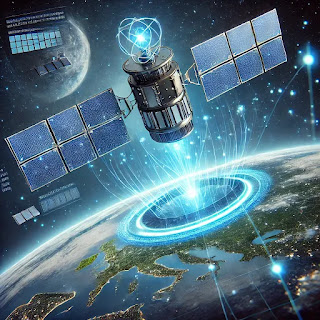A Decade of Discovery Comes to an End
After more than a decade of revolutionizing our understanding of the universe, the European Space Agency (ESA) has announced the retirement of Gaia, its ambitious space observatory dedicated to mapping the Milky Way. Launched in 2013, Gaia has played a pivotal role in charting billions of stars, refining our understanding of galactic evolution, and unlocking cosmic mysteries.

Now, as Gaia’s mission comes to an end, it leaves behind an astronomical legacy that will continue shaping space science for generations to come. Let’s explore Gaia’s journey, its monumental contributions, and what the future holds for galactic cartography.
Gaia: The Cartographer of the Cosmos
The Gaia mission was designed with one primary objective: to create the most precise three-dimensional map of our galaxy. By observing stars, asteroids, exoplanets, and even distant quasars, Gaia has provided an unprecedented look into the dynamics and structure of the Milky Way.
How Did Gaia Work?
Gaia used a method called astrometry, the precise measurement of the positions and movements of celestial objects. Equipped with two optical telescopes and a billion-pixel camera, it monitored the position, motion, brightness, and color of more than 1.8 billion stars. Over time, Gaia’s repeated observations enabled scientists to determine the distances of stars, their velocities, and even their physical characteristics.
Gaia’s Revolutionary Contributions
Gaia’s observations have led to some of the most significant breakthroughs in modern astronomy:
Mapping the Milky Way in Unprecedented Detail: Gaia provided the most accurate star maps, helping astronomers understand the structure and history of our galaxy.
Unraveling the Milky Way’s History: The observatory revealed past galactic mergers, showing evidence of how the Milky Way consumed smaller galaxies.
Discovering Exoplanets and Brown Dwarfs: Gaia detected exoplanets indirectly by observing tiny wobbles in the motion of their host stars.
Tracking the Movement of Stars: By measuring stellar motions, Gaia predicted the future shape of our galaxy and helped identify stars on collision courses with other celestial objects.
Enhancing Our Understanding of Dark Matter: Gaia’s precise measurements of star movements have provided crucial insights into the invisible dark matter shaping galaxies.
Identifying Rogue Asteroids and Comets: The telescope’s observations helped refine the orbits of asteroids and space debris within our solar system.
Why is Gaia Being Retired?
Although Gaia has provided invaluable data, the mission was never intended to last indefinitely. Several key factors contributed to its retirement:
Fuel Limitations: Gaia operates using a highly sensitive positioning system that requires fuel. Over time, the spacecraft has used up most of its propellant, making it harder to maintain its stability and orientation.
Hardware Degradation: Exposure to cosmic radiation and the harsh environment of space has gradually affected Gaia’s instruments, leading to reduced efficiency.
Mission Objectives Accomplished: The primary objectives of the mission—creating an extensive star catalog and providing data for astrophysical research—have been largely completed.
Technological Advances: New missions with improved capabilities are on the horizon, ensuring that Gaia’s work will be built upon and refined in future projects.
The Future of Galactic Cartography
Although Gaia is retiring, the legacy of its data will endure for decades. The information gathered will continue to fuel research in astronomy, astrophysics, and cosmology. ESA has also planned follow-up missions, such as PLATO (Planetary Transits and Oscillations of Stars), which will further explore exoplanets and stellar properties.
Moreover, NASA’s James Webb Space Telescope (JWST) and upcoming ground-based observatories, such as the Vera C. Rubin Observatory, will complement Gaia’s discoveries by providing deeper insights into the cosmos.
Gaia’s Final Legacy
As Gaia’s operations wind down, astronomers worldwide will continue to analyze its vast treasure trove of data. The mission has given us a celestial map with unprecedented accuracy, unlocking answers to age-old questions about our place in the universe. While Gaia may no longer be collecting new data, its influence will persist, guiding future generations of astronomers as they venture further into the mysteries of the cosmos.
Gaia’s retirement is not an end, but a new beginning for the field of galactic cartography. The wealth of knowledge it has provided ensures that our journey to understand the universe is far from over.
Multiple Choice Questions (MCQs)
1. What was the primary objective of the Gaia mission?
A) To search for extraterrestrial life
B) To create a detailed 3D map of the Milky Way
C) To study black holes exclusively
- D) To send astronauts to MarsAnswer: B) To create a detailed 3D map of the Milky Way
2. Which space agency launched the Gaia mission?
A) NASA
B) ISRO
C) European Space Agency (ESA)
- D) RoscosmosAnswer: C) European Space Agency (ESA)
3. What method did Gaia primarily use for its observations?
A) Spectroscopy
B) Astrometry
C) Radio Waves
- D) Infrared ImagingAnswer: B) Astrometry
4. How many stars did Gaia map during its mission?
A) Around 100 million
B) Around 500 million
C) More than 1.8 billion
- D) Exactly 2 billionAnswer: C) More than 1.8 billion
5. Which of the following is NOT a contribution of Gaia?
A) Discovering new galaxies
B) Mapping stellar movements
C) Tracking asteroids
- D) Studying the history of the Milky WayAnswer: A) Discovering new galaxies
6. What is one of the primary reasons for Gaia’s retirement?
A) A catastrophic system failure
B) Lack of scientific interest
C) Fuel limitations and hardware degradation
- D) It completed its 50-year missionAnswer: C) Fuel limitations and hardware degradation
7. What future mission is expected to continue Gaia’s work in stellar research?
A) PLATO
B) Voyager 3
C) Artemis
- D) Hubble 2.0Answer: A) PLATO



%20satellite%20in%20orbit,%20directly%20connecting%20with%20smartphones%20and%20remote%20devices%20on%20Earth.%20The%20satellite%20beams%20high-spe.webp)











